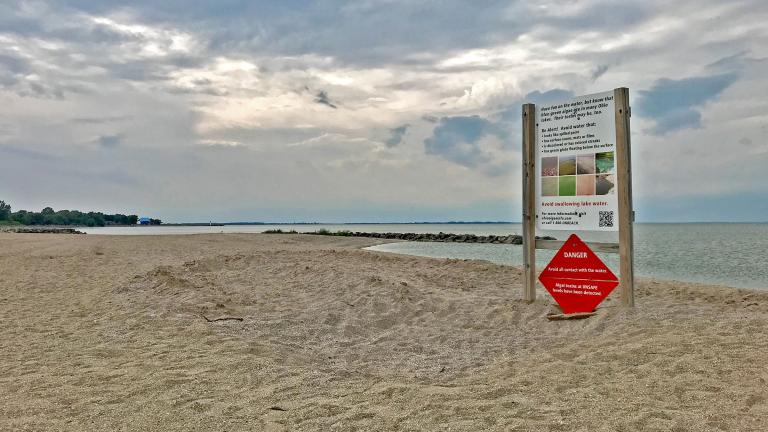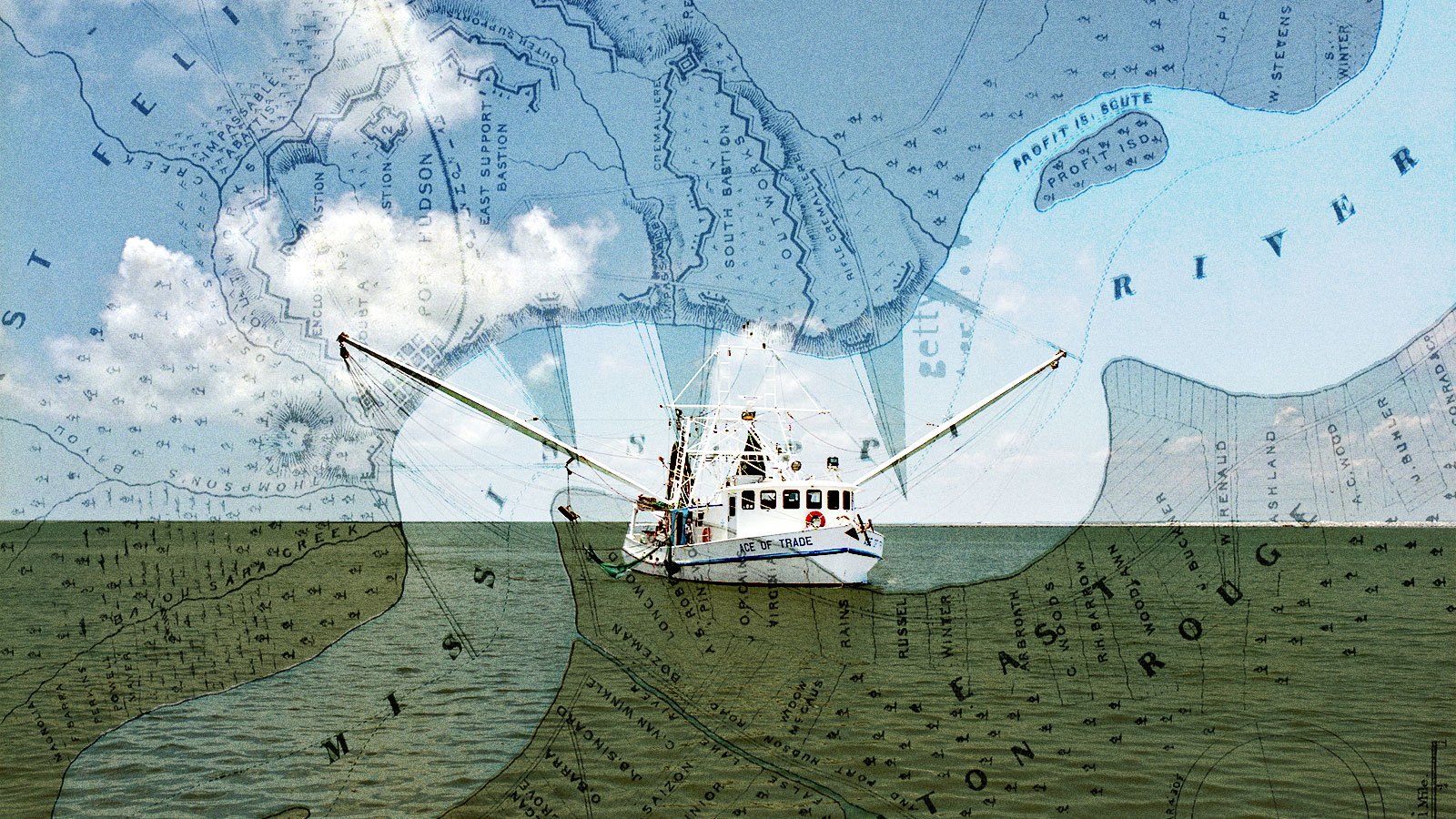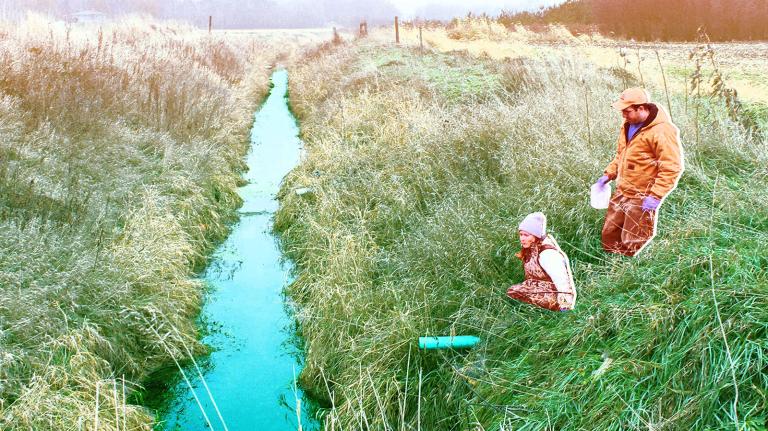This story was published in partnership with the Center for Public Integrity and The World.
The Ace of Trade trawler motored toward Dean Blanchard’s dock early last summer in southern Louisiana, its skipper slowly winching its nets into storage. Blanchard’s workers, strengthened by a lifetime at sea, worked shirtless in the humid summer air. It was the beginning of hurricane season, and 2019 was on track to be one of the wettest years on record in the U.S. With cigarettes in their mouths, they vaulted aboard the ship to shovel knee-high piles of fish off the fiberglass deck and into holding tanks, where they awaited the 12-inch-thick, semi-translucent pipes that would suck them into the warehouse.
Dean Blanchard Seafood, headquartered on the barrier island of Grand Isle in the Mississippi River Delta, is one of the largest shrimp suppliers in the United States. Blanchard is a squat man with a boxer’s nose, a soft-talking Cajun with the gravelly voice of a lifetime smoker. He fought hard for his livelihood after starting the business 37 years ago, when tensions ran high between established local shrimpers and newly arrived Vietnamese refugees. In the 1990s, Blanchard said that local shrimpers would sometimes pull alongside his dock opening fire with automatic weapons, angry at the market competition Blanchard encouraged through his dealings with the immigrants. He said he always shot back.
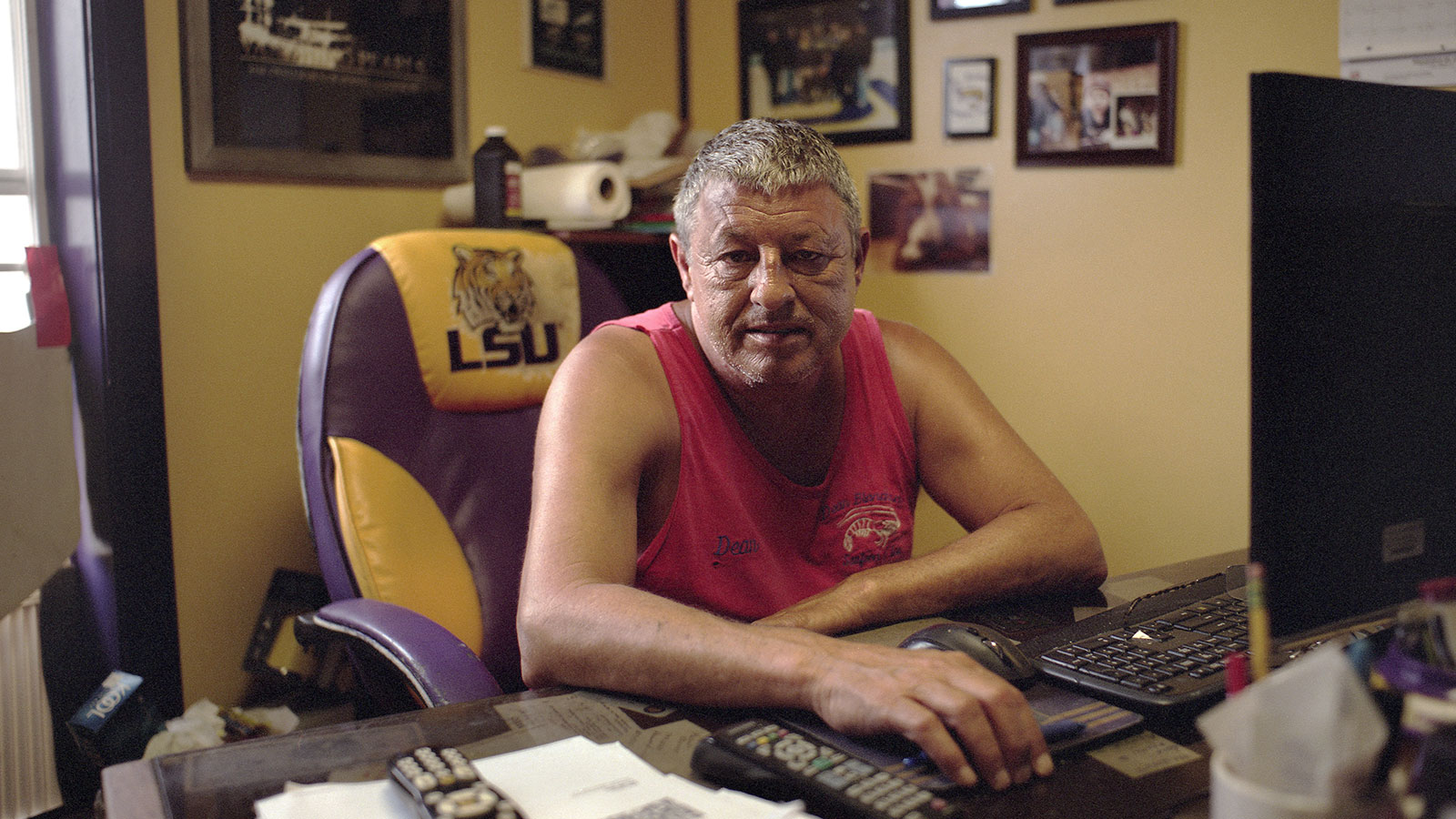
Dean Blanchard has been in business for 37 years, distributing shrimp off the barrier island of Grand Isle in the Mississippi River Delta. Spike Johnson
In 2010, Blanchard graduated to political battles with BP’s Deepwater Horizon disaster, a spill that sent 4.9 million barrels of oil into his fishing ground. Dean Blanchard Seafood took a hit, and Blanchard later told a reporter that he estimated his business was worth 15 percent of what it was before the spill. He testified in Congress and appeared on national news shows to lobby for his industry.
Increasingly, Blanchard and other Gulf Coast fishermen find themselves reckoning with a different type of pollution, a threat to ocean biodiversity and Louisiana’s $2 billion seafood industry that’s unrelated to oil and much harder to fix.
“Sometimes we’ll get thousands of pounds of shrimp a day, then the next day everything’s gone,” Blanchard said. “When the dead zone comes, it just kills everything.”
The Gulf of Mexico dead zone is a massive, oxygen-deprived swath of water concentrated off the coast of Louisiana and Texas, fed by polluted freshwater from states along the Mississippi River.
The Mississippi is born in Minnesota, its cold water bubbling over football sized rocks that edge the glacial Lake Itasca. From there it begins a walking-paced meander, 2,320 miles toward New Orleans. Like a topological funnel between the Rocky and Appalachian Mountains, the Mississippi drains 40 percent of the contiguous United States, carrying leftover nitrogen and phosphorus from fertilizer spread on farmland across the Midwest toward the Delta. The chemicals encourage the growth of algae, which suck up oxygen and choke marine life.
Politicians and environmental scientists from the states responsible for allowing the most fertilizer runoff into the Mississippi — Minnesota, Iowa, Illinois, and Indiana — are encouraging farmers to plant cover crops, change how they rotate crops, and take other measures to prevent polluted river water from barreling toward the Gulf and creating a zone of hypoxia (low oxygen) in one of the country’s most fertile fishing grounds. But these scattered efforts have yet to yield much success.
Small family farms, local conservation groups, and university scientists constitute the driving force of progress, leaving America’s large-scale corporate farmers silent in the background. There is no national prediction from the U.S. Environmental Protection Agency, its Hypoxia Task Force, or the U.S. Department of Agriculture indicating the total fertilizer load needed to shrink the dead zone. The problem is too complex for straightforward answers: Its outcome relies on rainfall, ocean temperature, soil health, and crop growth rates.
Last year, the dead zone measured as much as 6,952 square miles, larger than Connecticut and much bigger than the 5-year average of 5,770 square miles, according to the National Oceanic and Atmospheric Administration. Studies in the journal Science state that the global area of dead zones have quadrupled in the last 50 years, driven by a growing human population and an increase in the need for corn, soybeans, biofuels, and livestock feed.
Few places have felt the consequences harder than Louisiana, the country’s second-largest source of seafood after Alaska. NOAA estimates the dead zone costs the state’s seafood and tourism industries $82 million a year. It has made the work of fishing in the Gulf even more difficult. The dead zone grows in the summer after spring rains from the Midwest wash pollutants south, forcing ocean life to flee to areas where they wouldn’t normally be found. They would normally move from inshore nurseries to offshore spawning grounds, but the lack of oxygen blocks their migration.
So trawlers have been winding up with more small shrimp and fewer of the plump ones customers favor. That decreased volume comes even with improved equipment — new evolutions in radar, winches, and net technology. “So far we have 68,000 pounds a day for the month,” Blanchard said in July, usually a peak month. “Normally, we average about 90,000 pounds a day.”
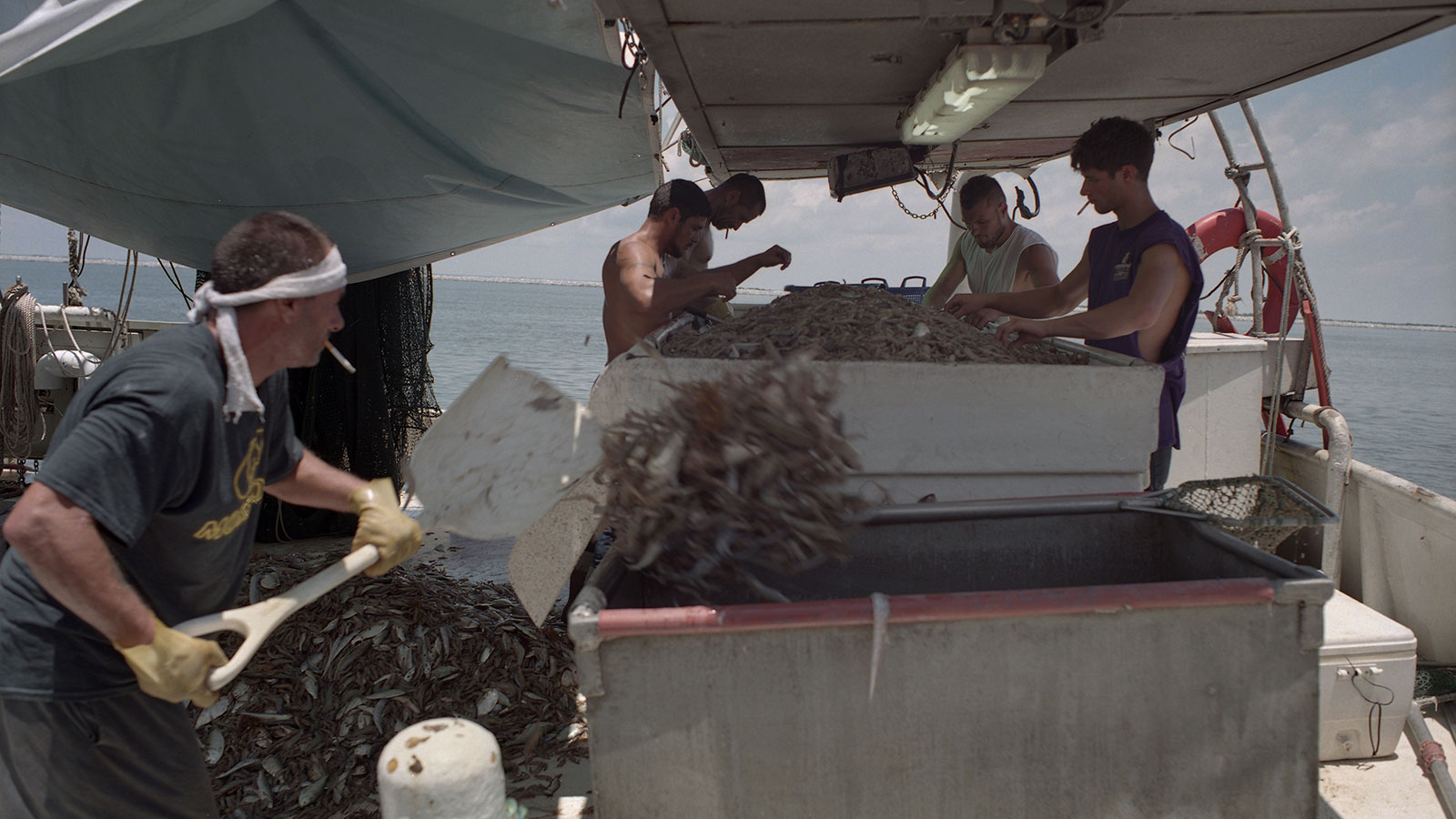
Dean Blanchard’s workers shovel piles of shrimp aboard the Ace of Trade off the coast of Grand Isle. Spike Johnson
The changing climate plays a role, too, with increased and more intense rainfall that speeds up erosion on farmland. In May, the output of the Mississippi River and its distributary, the Atchafalaya River, was 67 percent above the long-term average between 1980 and 2018, according to the U.S. Geological Survey. This discharge carried 156,000 metric tons of nitrate (the weight of more than 750 Statues of Liberty) and 25,300 metric tons of phosphorus into the Gulf of Mexico last May — 18 percent and 49 percent above long-term averages, respectively.
The obvious solution is to stanch the pollution at its source upstream. But if efforts to trap runoff from farms don’t succeed, wetland restoration projects in the Delta could form a defense of last resort by redirecting the Mississippi’s polluted flow into marshland where contaminants can be absorbed before they hit the ocean.
Seth Blitch, coastal and marine conservation director at Louisiana’s outpost of The Nature Conservancy, sat at his desk in Baton Rouge last June, below a wall-to-wall satellite image of the Mississippi Delta. Like an upside-down tree its printed lines fan out into the ocean.
Two stories below, the real-life Mississippi River slid past behind a levee. The river had breached its western bank, drowning shoreside factories and chemical plants beneath brown water full of earth, fertilizer, and vegetation from the north.
After the Great Mississippi River Flood of 1927 — which submerged 27,000 square miles of land along the river, killing hundreds of people — the U.S. Army Corps of Engineers began to raise its banks under the Flood Control Act passed the following year. Today, the Mississippi River levee system is 2,203 miles long, incorporating tributary flood walls and control stations. This mitigates flooding, but it gave birth to a new set of problems.
Before the 20th-Century building spree, a rush of floodwater would have spilled into wetlands, mangroves, and swamps where pollutants would be filtered out by vegetation, before the water seeped toward the sea. But now the levee system funnels water flow, pollutants, and sediment straight to the Gulf of Mexico. Hundreds of miles of navigation channels, pipelines, and exploratory canals built by the oil and gas industry compound the problem. Dredged soil from much of that construction was piled on the edges of waterways, forming piles known as spoil banks, or spoil levees, which impede the natural flow of water. “The process of wetland renourishment by fresh water and sediment in Louisiana is severed by levees,” Blitch said.
The Atchafalaya River Basin comprises about a million acres of wetlands, covering roughly the area of Rhode Island. It typically takes a third of the Mississippi’s water. The Atchafalaya Swamp acts as a filtration system, with plants feeding on nitrogen and phosphorus and slowing the flow of water traveling south.
In 2015, The Nature Conservancy bought nearly 5,400 acres of forest there, a preservation restoration project called the Atchafalaya River Basin Initiative. Once it gets approved by state regulators, the plan is to lower spoil banks to allow nutrient-filled water back into the marshes. “The idea is to restore the flow of water and sediment such that it both floods and drains from the property more like it would have before constructed levees and spoiling altered the flow,” Blitch said. He hopes that the project might one day form a restoration framework for states throughout the Mississippi River Basin.
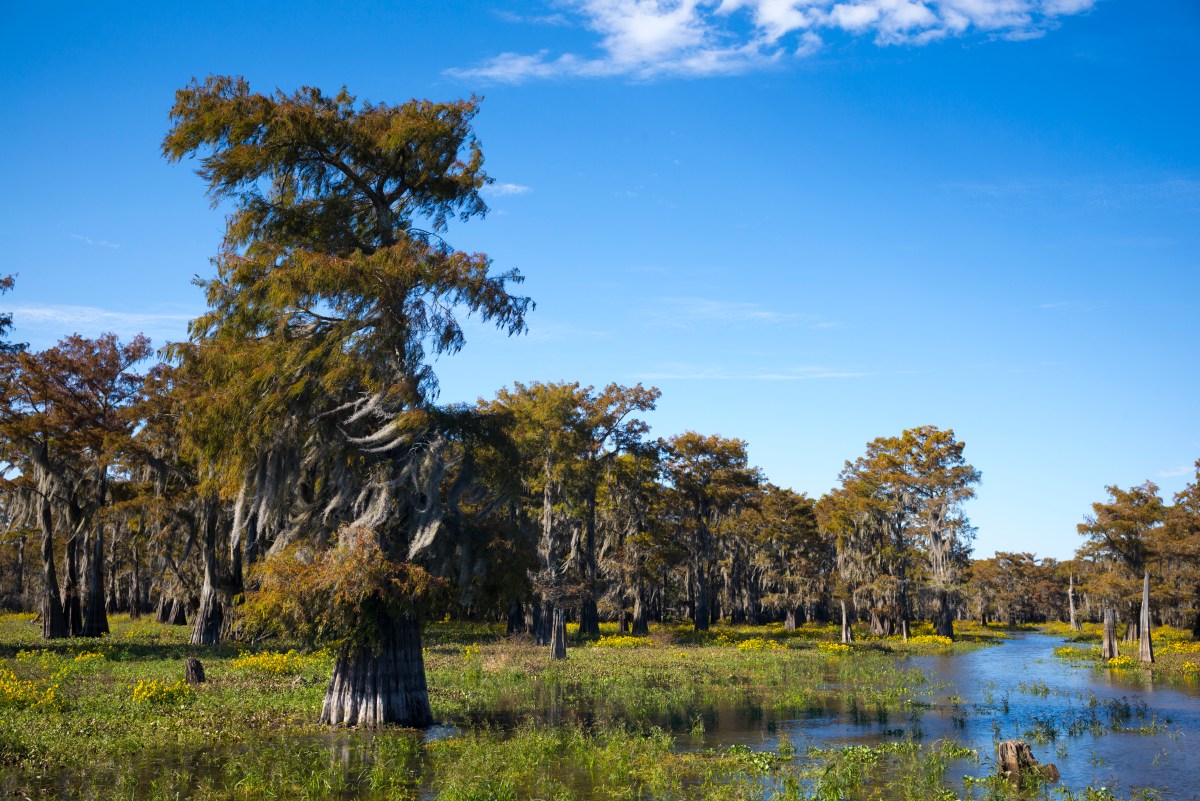
The Atchafalaya Swamp — part of the Atchafalaya Basin, the largest wetland in the United States — can filter nitrogen and phosphorus out of the Mississippi River as it flows south. Tim Graham / Getty Images
David Chauvin’s Seafood Company teeters on the silty marshland between the mouths of the Atchafalaya and the Mississippi Rivers in Dulac, Louisiana. On a Monday in June, teeming rain battered the tin roofs above Chauvin’s workers as they readied shrimp storage equipment, racing to unload boats escaping the storm. The rain bounced off concrete slick with diesel and fish oil. And a Bobcat mini-digger ferried bucketloads of ice between the freezer and shrimp storage bins, pushing its way through insulation curtains, orange headlights cutting through mist.
Chauvin’s wife, Kim, was frantic — one of their four shrimp trawlers was caught on a sand bar on Grand Isle, near Dean Blanchard’s place, 70 miles east. Switching from cell phone to cell phone, she tried to compile information and mount a rescue plan for a worst-case scenario.
“On the one hand we have tropical depressions, on the other we have this humongous dead zone,” she said. “We’re between a rock and a hard place.”
Kim has met with farming groups keen to help clean up the Gulf Coast. She found that local and family-owned farmers were sympathetic to the plight of shrimpers and recognized their role in the chain of pollution. “I don’t blame the mom and pops,” she said. “It’s usually big corporations who think they don’t have to change.”
Big or small, farmers are largely free to do what they want, because federal regulations don’t require them to curb fertilizer runoff. Oversight mostly falls to state agencies that are often keen on voluntary efforts in place of enforcing rules. Kim would like to see strict federal limits on agricultural pollution entering the Mississippi, backed by fines for non-compliance and reparations for historical damage to Louisiana’s shrimping industry.
Federal agencies have launched efforts to attack the problem. The USDA has granted millions of dollars to agricultural and conservation groups for the development of nutrient reduction strategies. And in 1997, the EPA organized what is now called the Hypoxia Task Force, which later pledged to shrink the dead zone by three quarters before 2015.
But at the end of 2014, with no progress in sight, the task force extended its deadline to 2035, with a new pledge to hit a 20-percent reduction by 2025.
Small family farms, local conservationists, universities, and some local governments have been experimenting with methods to curtail fertilizer runoff. State officials, including Brad Redlin, a manager for the Minnesota Department of Agriculture’s water-quality program, are trying to nudge farmers into better practices with incentives. They’ve started initiatives in which farmers and local governments split the costs of creating wetland filtration systems, and supported new markets for harvested cover crops so that farmers can recoup some of the cost of planting.
“There’s been little to no taste for regulating agriculture,” Redlin said. “But there’s a level of reassurance that conservation systems do exist out there in the countryside.”
In 2012, Redlin designed a voluntary certification program for farmers in Minnesota, in partnership with the USDA and EPA, that established standards for agricultural water quality. When farmers sign up, the state studies their farms using software that highlights bad practices. Redlin’s program suggests alternative methods to farmers to run their operations cleaner and more efficiently — the reduction of overall fertilizer use, the planting of cover crops, and limiting soil tilling, which leads to erosion.

Brad Redlin of the Minnesota Department of Agriculture designed a voluntary program to analyze farmer’s operations and suggest ways to make them more efficient. Spike Johnson
In 2016, his network of 15 state certifiers began walking across Minnesota’s farmland, field by field, to begin assessments. The process appeals to farmers who want an assessment of the health of their whole farm. If the farm is not up to par, the farmer might have to plant cover crops or build buffers designed to interrupt the flow of runoff. Redlin now has 731 producers certified over a total area of 489,385 acres.
“It’s often expressed that 70 percent of the problem is coming from 20 percent of the people; that’s not invalid,” Redlin said. “But it seems to be a different cliché, like death by a thousand cuts. Every farm is a little bit leaky and the cumulative result is a dead zone in the Gulf.”
Mike Naig, Iowa’s secretary of agriculture, smoothed his navy-blue suit jacket as he sat at a polished wood conference table preparing to co-chair the 2019 meeting of the Hypoxia Task Force in Baton Rouge. Naig comes from a long line of farmers and still travels back to his parent’s farm in northern Iowa to help work the land.
“We all understand that we feed into the Gulf,” he said. “And shame on us if we don’t take advantage of the opportunity to show that we can be effective.”
Naig works as an intermediary between farmers, the USDA, the EPA, and Congress, drumming up support for agricultural conservation projects through funding, policy changes, and permitting. He helps public and private interests collaborate — farmers, fertilizer sellers, environmental scientists, and governments — lining up access to equipment, technical assistance, and financial aid for nutrient-reduction projects. Naig has 14 watershed demonstration projects across the state, which show how cover crops, bioreactors, and wetlands can reduce nutrient runoff on working farmland on a small scale.
According to Naig’s department, his efforts have led to 1 million acres of cover crops planted and 88 completed wetlands, with another 30 under development across Iowa.
Naig thinks federal regulations to curtail runoff would backfire. If it was a regulatory obligation, he argued, the dynamic between farmers and government would breed bitterness. Top-down structures for conservation, enforced federally, he said, would mean flip-flopping on industrial and environmental goals every time a new president landed in the White House.
“We want people to use their own innovative approaches,” Naig said. “I think we’ll get to a better place, and we’ll get there faster, through unleashing people’s creativity.”
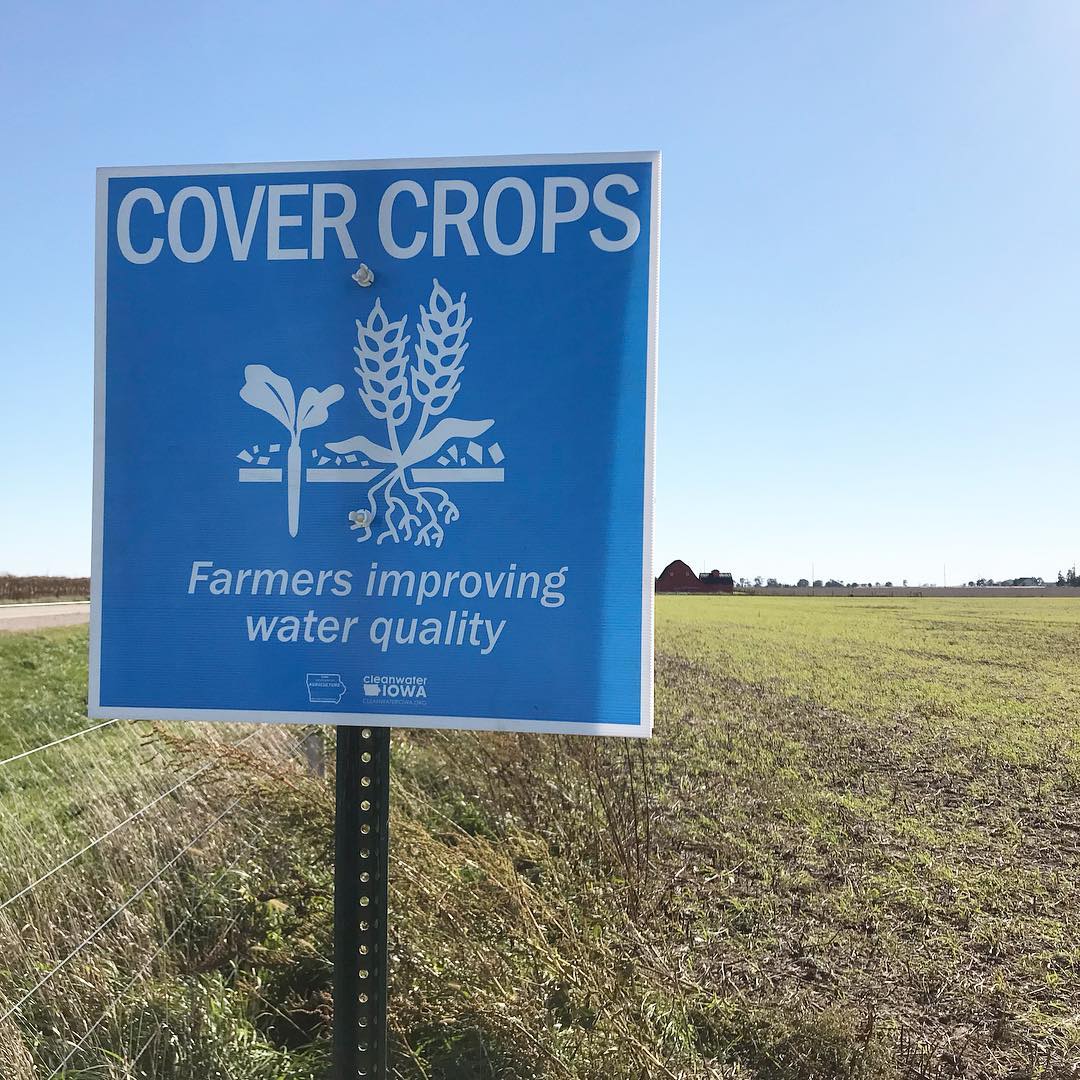
In a 2017 Instagram post, the Iowa Department of Agriculture boasted that farmers in the state planted “an estimated 760,000 acres of cover crops.” Iowa Department of Agriculture
Iowa’s 2013 Nutrient Reduction Strategy, a state government initiative to reduce nitrogen and phosphorus pollution, promised a 45 percent decrease in fertilizer runoff by 2035, but despite Naig’s efforts there’s been no change yet. Experts say large-scale crop producers have yet to make adaptations to their methods of growing.
For shrimpers living along the Delta like Dean Blanchard and Kim Chauvin, patience is wearing thin. “On a congressional level we need to say enough is enough,” she said. “We need to list annual goals for change, and stick to the plan.”
She said that shrimpers want face-to-face meetings with large-scale commercial farmers and fertilizer companies. They want to show the consequences of current methods of farming on those who live and fish on the coasts. They want fines and regulation for offending agricultural operations and a return to healthier waters.
“We need them to understand what they’re doing to the fishing industry,” Chauvin said. “The states above us should be paying something to the industry that they’re destroying.”
Written and photographed by Spike Johnson with support from the Pulitzer Center on Crisis Reporting. This story was published in partnership between Grist, the Center for Public Integrity — a nonprofit, nonpartisan newsroom that investigates betrayals of public trust — and The World, a radio program that crosses borders and time zones to bring home the stories that matter.
